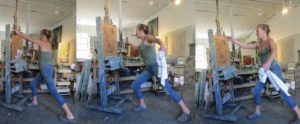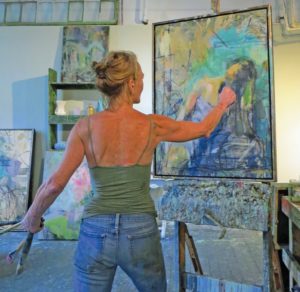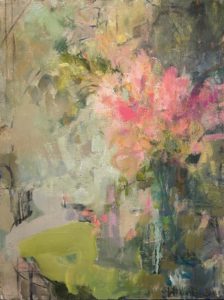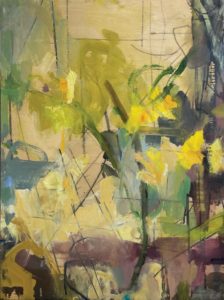Cynthia Packard says she dances with her paintings. It must be a tango or flamenco; it’s not a waltz. Her intensely physical approach to painting is intuitive, abrupt, sure, and wildly passionate. Yet at the end of the process the painting is almost serene. It’s like an explosion in reverse. What had been chaos comes together as the pieces layer their way back to exactly where they were meant to be.
A new show of Packard’s work opens on Friday, July 1 at Berta Walker Gallery in Provincetown. She is also holding open studio hours at 96 Bradford St. from noon to 4 p.m. daily throughout the summer.

Packard studied martial arts and yoga. She is lithe and sinewy, and appears poised to spring into action at any moment.
She calls her brushes her soldiers — she says it is a war and uses up to 30 large brushes every day. A tabletop palette is prepared with glistening coils of paint. Each color has its own brush. But the work doesn’t start with paint. It starts with a single line, usually drawn in charcoal. It can be vertical or horizontal. It must be straight and goes from one edge of the canvas to the opposite.
The walls of her high-ceilinged studio are lined with paintings. There is a lot of natural light. A large mirror dominates a portion of one wall. Open cabinets house a collection of vases, art pottery, and items of curiosity and interest. She finds a piece of cardboard, puts it on her easel like a canvas, and makes the first line.

“It’s a relationship,” she says, indicating the two rectangles created by the first line. “It’s not only the shapes — the edges have now been interrupted.” She says it is like music as she traces the outer edge, sounding long and short notes, some soft, some loud and guttural.
“Where to put the next line?” she asks. She explains that they can’t be similarly placed. Each must divide the space in a unique way. “What’s this about?” She draws a second straight line. If the first was vertical, this one must be horizontal. She points at the horizontal line. “This could be the table; it could be the floor,” she says. “I’m not invested in what it is. I’m getting to know the source.”
A third line, diagonal, is laid down. She steps back, looks, moves in fast, takes out part of one line, puts in another. A vase of wildflowers sits on a low table in front of her. It’s the subject of the painting, but for now she is understanding the relationship of the spaces created by each part of the composition. There is no hint of vase or flowers yet.

“Stay away as long as possible from the most beautiful thing,” she says as she starts to add lines in colors. “Hold it. Like horses, you can’t get out of the gate for a long time. You have to hold it because once the gate opens, boom!”
She takes the canvas and rotates it 90 degrees. Adds paint, rotates again, adds more paint. It’s completely abstract, with interesting lines and colors. Then she adds a curved line.
“I’m staying away from the things I love the most,” she says. “I want them to evolve, reveal themselves. I don’t want to make them. That’s forcing my intention on the painting.”

She adds more paint. “Each flower has a direction. Leaves go different ways. I have to know what each line is. Thicker? Thinner? Give it integrity, make it about more than a vase of flowers.” She’s been moving in close, then stepping away from the canvas — taking away a line, adding another, covering it all with color. “You have to get in and get off fast,” she says over her shoulder.
Eventually, she gets to the vase, ignoring the shape and concentrating on the color, and somehow the flowers appear almost miraculously, and with the least addition of paint. “It’s like writing,” she says. “Most of it is editing. You have to put something down to react to — then edit, edit, edit.”

She says she puts all her knowledge and experience on the table. “I can feel it before it comes down,” she says. “I feel the blood coming down my arms into my hands and I know I’m being given the gift again.” She says she just had a long dry spell. Still, she came, painted, scraped it off, painted over it.
She has said she never knows what a painting will be and she never knows when it’s done. She laughs and says she wishes there were two of her — one to paint, one to say stop. She had a whole series of paintings done, ready to show last year. Then something in the corner of one bothered her. She worked on it, which led to working on the next and the next until they were all, in her opinion, ruined.
Packard never took a painting class, but she comes from an illustrious family. Her great-grandfather, the impressionist painter Max Bohm, was an important member of the early Provincetown arts colony. His granddaughter, Anne Packard — Cynthia’s mother — is a well-known artist of atmospheric seascapes.

She credits drawing lessons with Fritz Bultman and Hans Hofmann’s push-pull technique with leading to her own unique style. “It was a gift from God,” she says about her time with Bultman. “I was his only student. I really learned. It’s a methodology, a science.”
She studied sculpture and art history at Mass. College of Art. When she took up painting, she copied the masters. “I took hundreds of pieces of paper and painted every kind of yellow I could imagine, every green,” she says. “I taught myself.”
Packard acknowledges a struggle with depression. Though many describe her paintings as ethereally beautiful, she says each has an edge of darkness. She has been working on a series with refugee mothers and babies following the invasion of Ukraine.
She says her goal has never been to paint a pretty picture: “I want the painting to have a reason to survive and to live.”
She doesn’t just dance with her paintings. She talks to them. “What do you want next?” she asks the canvas. “Oh, you want this? You have to wait, orange, and the blue is screaming, ‘Over here!’ I have to be the orchestrator, say no, the strings stay down, the horns come up.”
She puts a recent portrait of her longtime model, artist Jen Bradley, on the easel and talks about the emotional connection they have. There are no facial features in the picture, but the sense of the model is fully captured.
“I’m in love with line and color,” she says. “This painting is like a haiku. It gives the essence rather than giving everything.”
The Space Between the Breath
The event: Cynthia Packard at Berta Walker Gallery
The time: July 1 to 23; opening reception Friday, July 1, 6 to 8 p.m.
The place: Berta Walker Gallery, 208 Bradford St, Provincetown.
The cost: Free
